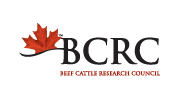Reducing ammonia emissions from beef production
| Project Code: | ENV.02.13 |
| Completed: | March 2018 |
Project Title:
Defining the Environmental Footprint of Canadian Beef Production
Researchers:
Tim McAllister, Ph.D. and Karen Beauchemin, Ph.D. tim.mcallister@agr.gc.ca
Getahun Legesse, Ph.D., Emma McGeough Ph.D., Kim Ominski, Ph.D. (University of Manitoba) and Roland Kroebel, Ph.D., Aklilu Alemu, Ph.d., Shabtai Bittman, Ph.D.(Agriculture and Agri-Food Canada) Lilong Chai, Ph.D. (Iowa State University)
Background:
As the world’s fifth largest exporter of beef, Canada produces approximately 2% of the world’s beef, contributing an estimated $33 billion worth of sales of goods and services either directly or indirectly to our economy. While the benefits of having cattle on the landscape are recognized - cattle transform inedible forages into high quality protein, protect marginal lands from erosion, promote biodiversity, and remove carbon from the air and store it in soil - there are also recognized negative environmental impacts associated with beef production, including ammonia (NH3) emissions, all of which need to be quantified to serve as benchmark for improvements over time.
In Canada, agriculture is responsible for over 90% of the total NH3 emissions resulting from human activities. The livestock sector represents approximately 65% of these emissions, with the beef sector being the major contributor.
As the global population and associated demand for food production continues to grow, strategies to reduce not only absolute ammonia emissions but also emissions per unit of product are needed to further improve upon Canadian beef producers’ environmentally sound production practices. With this information, Canada’s cattle producers can tell their story regarding the true impacts and benefits of the cattle industry on the environment.
Objective:
To compare ammonia emissions associated with Canadian beef production in 1981 and 2011 and assess the effects of changes in management practices and animal performance on ammonia emissions and emission intensity - the amount of NH3 associated with the production of one kilogram of beef.
What they did:
Ammonia emissions associated with beef production in Canada were estimated using a nation-wide mass balance approach based on the total amount of ammoniacal nitrogen in manure. The mass balance calculation accounted for nitrogen intake as feed, retention in animal tissue, milk and the fetus, and excreted nitrogen. Pertinent equations were employed to quantify NH3 emissions related to confined feeding and grazing, manure storage and land application of manure. Temporal and regional differences in cattle categories (cows, replacement heifers, bulls, calves, finishing and backgrounding cattle), feed types and management systems, average daily gains and carcass weights were accounted for.
In addition, the impact of increasing levels of dried distillers grains with solubles (DDGS), a co-product of grain-based fuel ethanol production that is used as a source of protein and energy in backgrounding and finishing diets, was examined.
What they learned:
Overall, total NH3 emissions from Canadian beef production were 27% greater in 2011 than in 1981 while the total nitrogen consumed by Canadian beef cattle lost as NH3-N was similar for both 1981 and 2011, averaging 22%. These results are expected to be used as a yardstick against which future improvements can be measured.
There were also differences among cattle categories for these two time periods. In 2011, cattle destined for slaughter (i.e., backgrounding and finishing cattle) contributed more NH3 emissions than breeding cows (46% vs. 40%) while in 1981 the contribution from cows was greater than slaughter cattle (50% vs. 35%). Increased NH3 emissions from the slaughter group in 2011 compared to 1981 was due to the increased number and size of feedlots, as well as higher numbers and weight of finished cattle. Heavier cattle consume more feed and excrete more manure as compared to lighter-weight cattle. Ammonia emissions are higher for confined feeding compared with other emissions sources for the Canadian beef herd.
Ammonia emissions are associated with confined feeding, manure storage, land spreading and animal grazing. Emission sources were generally consistent across years, with losses being highest with confined feeding (avg. 40%) and lowest with grazing (12%). Confined feeding and manure storage collectively accounted for more than two thirds of total NH3 emissions in both years.
The average emissions per animal in 2011 were 2.4 kg higher per animal per year than in 1981, however the emissions intensity - the amount of NH3 emitted per kg of beef - decreased by 20% over the same period. This decline inintensity is related mainly to improvements in production efficiency over the 30-year time frame. Between 1981 and 2011 reproductive efficiency, average daily gain and slaughter weights increased, resulting in an overall improvement in productivity per breeding herd and efficiency per kg of beef produced. Increased extended grazing of cows (e.g., swath, stockpiled and bale grazing) in 2011 compared with 1981 reduced the NH3 emissions associated with confined feeding systems, further decreasing emissions intensity.
Feed management practices can impact NH3 emissions. Substituting the grain portion with DDGS in backgrounding and finishing diets increased NH3 emissions, offsetting reductions in NH3 emission intensity attained through other improvements. It was clear that balancing dietary protein levels with the animal’s protein requirements was the most effective means of lowering NH3 emissions.
What it means:
An overall reduction in NH3 losses per unit of beef between 1981 and 2011 is due mainly to improvements in production efficiency. However, adoption of certain cattle production, feed and manure management practices can reduce NH3 emissions while others can increase emissions. Examining changes in beef management practices over time in response to profitability and policy signals are necessary to continually assess the impact of beef production on NH3 emissions and air quality at local and regional scales.
Strategies planned or implemented to mitigate NH3 emissions can have unintended consequences in terms of the emissions of other greenhouse gases and airborne pollutants. For example, adopting manure injection to mitigate NH3 emissions may lead to leaching of nitrate and higher nitrous oxide emissions than manure surface application of manure. Therefore, a whole farm system approach and an understanding of the complete nitrogen cycle are very important for understanding the true implications of any mitigation strategy.








